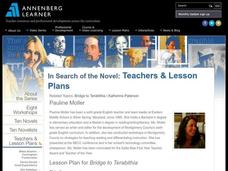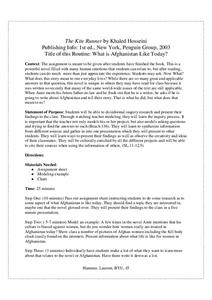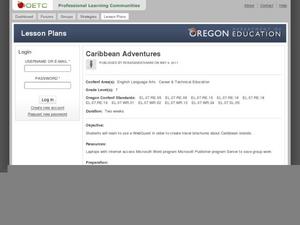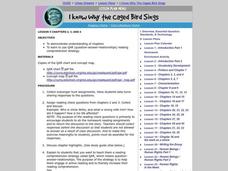Scholastic
A House for Hermit Crab
Engage young marine biologists in a reading of Eric Carle's A House for Hermit Crab with a fun hands-on activity. Given a set of clipart images of the different aquatic animals that appear in the book, children identify each one during a...
Curated OER
The Giver: Lesson 1
Do “memories need to be shared?" Are “memories…forever?" Would you give up memory to live in a perfect world? Introduce a unit centered on Lois Lowry’s utopian/dystopian novel The Giver with a series of activities that has groups...
Curated OER
Bridge to Terabithia
Students explore scenes from Katherine Paterson's book, Bridge to Terabithia. For this visualization lesson, students listen to the story read aloud. The students then choose words and phrases that paint a picture in their heads....
Curated OER
Exploring Arizona's Biotic Communities Lesson 1: Mapping Biotic Communities
As part of a unit on Arizona's biotic communities, young ecology learners create a map. They describe how humans and animals adapt in their habitat. They take notes and create graphic organizers from articles they read. Beautiful maps,...
Howard Hughes Medical Institute
Central Dogma and Genetic Medicine
Scientists work every day to find solutions to genetic diseases. Scholars learn about the process of gene sequencing, mutations, and the results. They explore genetic diseases and therapies to intervene and help and, through case...
Chymist
Writing Chemical Equations
Communicate chemistry clearly with a concise guide to writing chemical equations. It covers everything from the parts of a chemical equation to the different types of reactions that budding chemists may encounter.
Super Duper Publications
How to Help Your Child Understand and Produce “Wh” Questions
Practice who, what, where, when, and why with a series of activities designed for forming and answering questions. Kids work on choosing the correct wh- word to ask the question they want with a word chart, conversational cues, and...
EngageNY
Editing Sentences and Creating Visual and Multimedia Displays for a Presentation
Let's get visual. Pupils plan visual displays to accompany their upcoming opinion speech presentations. Additionally, they practice editing sentences for clarity before revising their speech drafts.
BW Walch
Vending Machine Bans Increase in Schools Nationwide
Does a ban on vending machines infringe on student rights, or do school officials have an obligation to monitor foods sold on school grounds? Your class members will explore the educational, health, and financial issues related to...
EngageNY
Building Background Knowledge: The Dinka and Nuer Tribes
Building on a previous lesson plan, readers continue using context clues to learn new vocabulary. Additionally, they continue working on their Gathering Evidence graphic organizers, making connections between an informational text and A...
Scholastic
Ask the Author
Here is a quick activity that could help your kids with their reading comprehension. They practice a classic strategy that gets them to start asking questions about what they are reading, while they are reading it. They write out...
Curated OER
What are the Elements of Poetry
Students read the poem "Ode to Pablo's Tennis Shoes" and analyze the form, figurative language, and mood. They complete a T-chart containing what they have learned about Pablo and the evidence from the poem supporting their conclusions.
Curated OER
Word Maps Teaching Ideas
In this literacy worksheet, students are given a graphic organizer to complete or are presented it as part of the lesson developed from using this sheet.
Curated OER
Angry Words: What Goes Around Comes Around
Students examine how angry words can effect the people and environment around them and identify ways to cope with angry feelings. They listen to the book Andrew's Angry Words by Dorothea Lachner, and participate in a simulation of how...
Curated OER
The Kite Runner: What is Afghanistan Like Today?
After completing Khaled Hosseini's The Kite Runner, readers research a topic of interest and prepare a five-minute presentation, and share their findings with the class.
Curated OER
I Can Do Anything
Students investigate what boys and girls can do after participating in readings and class discussions. They examine how gender stereotypes and name-calling can influence what students think they can and cannot accomplish.
Curated OER
Caribbean Adventures: Research and Desktop Publishing
If you want an interesting way to teach about the Caribbean that incorporates technology, this might be your answer. Class members conduct a WebQuest to gather information about Caribbean islands and create a travel brochure using...
Curated OER
Classify By Topic
Students explore and evaluate poetry. In small groups, they read and summarize poems, complete a handout, create and perform a dramatization of a poem, and write a journal entry in response to their performance.
Curated OER
Is this the right book for me?
Sixth graders recognize strategies for selecting nonfiction texts. In this book selection instructional activity, 6th graders practice procedures for knowing if the book is just right for them. Students select from a variety of texts and...
Curated OER
I Know Why the Caged Bird Sings
Students complete QAR activities for Maya Angelou's I Know Why the Caged Bird Sings. In this literary analysis lesson plan, students read chapters 2 and 3 and complete reading check questions. Students discuss chapter highlights and the...
Curated OER
Making a Grocery List
Students assess a variety of reading strategies to properly develop a list of grocery words. They draw conclusions about environmental print by matching labels to sentences. Real-life words utilized weekly becomes an asset to the...
Curated OER
Food Chain Chant
Students memorize a poem using various reading strategies to reinforce the concept of the food chain and the terminology associated with it.
Curated OER
The Vast Ocean
Students explore oceans, and demonstrate reading comprehension skills, including reading strategies, inference, literal meaning, and critical analysis.
Curated OER
What is Light?
Students explore different types of light, and demonstrate reading comprehension skills, including reading strategies, inference, literal meaning, and critical analysis.

























